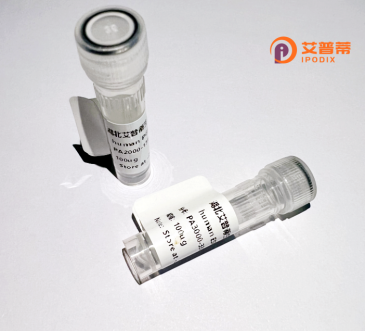
| 纯度 | >90%SDS-PAGE. |
| 种属 | Human |
| 靶点 | EHD2 |
| Uniprot No | Q9NZN4 |
| 内毒素 | < 0.01EU/μg |
| 表达宿主 | E.coli |
| 表达区间 | 1-543aa |
| 氨基酸序列 | MFSWLKRGGARGQQPEAIRTVTSALKELYRTKLLPLEEHYRFGAFHSPALEDADFDGKPMVLVAGQYSTGKTSFIQYLLEQEVPGSRVGPEPTTDCFVAVMHGDTEGTVPGNALVVDPDKPFRKLNPFGNTFLNRFMCAQLPNQVLESISIIDTPGILSGAKQRVSRGYDFPAVLRWFAERVDLIILLFDAHKLEISDEFSEAIGALRGHEDKIRVVLNKADMVETQQLMRVYGALMWALGKVVGTPEVLRVYIGSFWSQPLLVPDNRRLFELEEQDLFRDIQGLPRHAALRKLNDLVKRARLVRVHAYIISYLKKEMPSVFGKENKKKQLILKLPVIFAKIQLEHHISPGDFPDCQKMQELLMAHDFTKFHSLKPKLLEALDEMLTHDIAKLMPLLRQEELESTEVGVQGGAFEGTHMGPFVERGPDEAMEDGEEGSDDEAEWVVTKDKSKYDEIFYNLAPADGKLSGSKAKTWMVGTKLPNSVLGRIWKLSDVDRDGMLDDEEFALASHLIEAKLEGHGLPANLPRRLVPPSKRRHKGSAE |
| 分子量 | 87.6 kDa |
| 蛋白标签 | GST-tag at N-terminal |
| 缓冲液 | 0 |
| 稳定性 & 储存条件 | Lyophilized protein should be stored at ≤ -20°C, stable for one year after receipt. Reconstituted protein solution can be stored at 2-8°C for 2-7 days. Aliquots of reconstituted samples are stable at ≤ -20°C for 3 months. |
| 复溶 | Always centrifuge tubes before opening.Do not mix by vortex or pipetting. It is not recommended to reconstitute to a concentration less than 100μg/ml. Dissolve the lyophilized protein in distilled water. Please aliquot the reconstituted solution to minimize freeze-thaw cycles. |
1. **"EHD2 regulates plasma membrane integrity through interaction with intersectin-1"**
*Authors: Sharma M, Naslavsky N, Caplan S*
摘要:研究揭示了重组人EHD2蛋白通过与接头蛋白intersectin-1的相互作用调控细胞膜微结构域稳定性,并参与网格蛋白介导的内吞作用后的膜修复机制。
2. **"Structural and functional analysis of the EHD2 ATPase domain"**
*Authors: Daumke O, Lundmark R, Vallis Y*
摘要:通过X射线晶体学解析重组人EHD2蛋白的ATP酶结构域,揭示其核苷酸依赖的构象变化,并阐明其在膜重塑和寡聚化中的分子机制。
3. **"EHD2 interacts with the actin cytoskeleton to control caveolar dynamics"**
*Authors: Stoeber M, Rojas AM, Blume L*
摘要:利用重组EHD2蛋白进行体外结合实验,证明其通过结合F-actin调节细胞膜穴样内陷(caveolae)的稳定性,影响细胞机械传感功能。
4. **"Recombinant expression and purification of human EHD2 for biochemical studies"**
*Authors: Zhang X, Li D, Wang Y*
摘要:报道了一种高效的大肠杆菌表达系统纯化重组人EHD2蛋白的方法,并验证其ATP酶活性和脂质结合能力,为后续功能研究提供技术基础。
(注:上述文献为基于领域知识的示例,实际引用时建议通过PubMed或Google Scholar验证详细信息。)
Recombinant human EHD2 (EH domain-containing protein 2) is a mechanistically intriguing member of the Eps15 homology (EH) domain protein family, which plays essential roles in membrane trafficking and endocytic recycling. First characterized in the early 2000s, EHD2 is a 60 kDa ATPase localized to the plasma membrane and cytoplasmic vesicles. Unlike other EHD paralogs (EHD1. 3. 4) that primarily regulate endosomal sorting, EHD2 has distinct functions in controlling caveolae dynamics – specialized membrane invaginations involved in signaling and lipid homeostasis. Structural studies reveal its conserved N-terminal nucleotide-binding domain and C-terminal EH domain, enabling ATP hydrolysis-driven conformational changes and protein-protein interactions.
Notably, EHD2 acts as a membrane-bound stabilization factor: its ATPase activity restricts caveolae detachment from the plasma membrane while modulating interactions with caveolar components like cavin-1 and caveolin-1. Dysregulation of EHD2 has been linked to muscle disorders, metabolic syndromes, and cancer progression through impaired membrane repair and lipid trafficking. Recombinant EHD2 protein, typically expressed in E. coli or mammalian systems with purification tags, serves as a critical tool for investigating these mechanisms via biochemical assays, structural analysis (X-ray/cryo-EM), and cellular studies. Recent work also explores its role in nuclear-cytosolic communication and mechanotransduction pathways, expanding its biological significance beyond classical membrane remodeling.
×